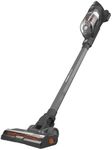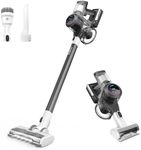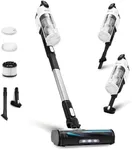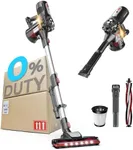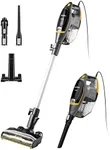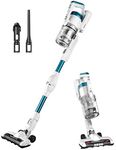Buying Guide for the Best Cordless Stick Vacs
Choosing the right cordless stick vacuum can make a big difference in how effectively and efficiently you can clean your home. These vacuums are known for their convenience and ease of use, but there are several key specifications to consider to ensure you get the best fit for your needs. Understanding these specs will help you make an informed decision and find a vacuum that meets your cleaning requirements.Battery LifeBattery life refers to how long the vacuum can run on a single charge. This is important because it determines how much cleaning you can do before needing to recharge. Battery life can range from 15 minutes to over an hour. If you have a larger home or plan to use the vacuum for extended cleaning sessions, look for models with longer battery life. For smaller spaces or quick clean-ups, a shorter battery life may be sufficient.
Suction PowerSuction power indicates how effectively the vacuum can pick up dirt and debris. This is crucial for ensuring a thorough clean, especially on carpets and rugs. Suction power is often measured in air watts (AW) or volts (V). Higher suction power is better for deep cleaning and tackling tough messes, while lower suction power may be adequate for hard floors and light cleaning tasks. Consider the types of surfaces you'll be cleaning most often to determine the right level of suction power for you.
WeightThe weight of the vacuum affects how easy it is to maneuver and carry around. Lighter models are easier to handle, especially if you need to clean multiple floors or carry the vacuum up and down stairs. Weight can range from around 3 pounds to over 10 pounds. If you have physical limitations or prefer a more lightweight option, look for models on the lighter end of the spectrum. Heavier models may offer more features or better performance but can be more cumbersome to use.
Dustbin CapacityDustbin capacity refers to how much dirt and debris the vacuum can hold before it needs to be emptied. This is important for convenience and efficiency, as a larger dustbin means fewer trips to the trash can. Capacities can range from around 0.3 liters to over 1 liter. If you have a larger home or pets that shed a lot, a larger dustbin capacity will be beneficial. For smaller homes or less frequent cleaning, a smaller dustbin may be sufficient.
Filtration SystemThe filtration system captures dust, allergens, and other particles, ensuring that the air expelled by the vacuum is clean. This is especially important for people with allergies or asthma. Look for vacuums with HEPA filters, which can trap very small particles and provide better air quality. Some models have washable filters, which can be more cost-effective in the long run. Consider your sensitivity to dust and allergens when choosing the right filtration system.
Attachments and AccessoriesAttachments and accessories can enhance the versatility of your vacuum, allowing you to clean different surfaces and hard-to-reach areas. Common attachments include crevice tools, dusting brushes, and motorized pet tools. Think about the specific cleaning tasks you need to perform, such as cleaning upholstery, car interiors, or pet hair, and choose a vacuum that comes with the appropriate attachments. More attachments can add to the vacuum's functionality but may also increase its complexity.
Charging TimeCharging time is the amount of time it takes to fully recharge the vacuum's battery. This is important for planning your cleaning schedule and ensuring the vacuum is ready when you need it. Charging times can range from a few hours to overnight. If you need to use the vacuum frequently or for extended periods, look for models with shorter charging times. For occasional use, longer charging times may be acceptable.




